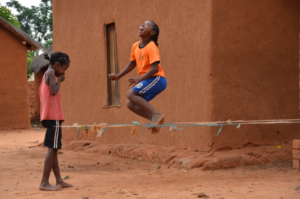
Malagasy girls play outside their homes in Ihosy, Madagascar. © 2016 Mohamad Syar/CCP, Courtesy of Photoshare
Adolescents and youth – defined by the World Health Organization (WHO) as those ages 10 to 24 – make up a quarter of the world’s total population. They are a driving force, shaping our global future. However, they are too often unable to reach their potential. According to the WHO, 1.3 million adolescents died from preventable or treatable causes in 2015. In girls aged 15 to 19, suicide and complications during pregnancy and childbirth are the top two leading causes of death. Two million adolescents are living with HIV worldwide, 2.5 million girls under the age of 16 have given birth and 15 million under the age of 18 are married. A shocking 120 million under the age of 20 have been a victim of sexual violence. These numbers urgently underline the need for health programs specific to this unique population that prioritize their needs.
Unfortunately, adolescent-focused programs specifically have often failed to reach those most in need and have had little effect on sexual and reproductive health behaviors – either because the approaches used, such as establishing youth centers, relying on peer education and holding one-off high level meetings were ineffective, or because program duration was too short. HC3 looked at new, innovative, sustainable ways to fill research gaps and to reach youth and adolescents through social and behavior change communication (SBCC). HC3 worked across multiple health areas, including HIV, family planning (FP) and reproductive health, to ensure that programs were designed well, implemented over longer periods of time, with greater intensity.
HC3 has undertaken a number of proven strategies to engage adolescents and youth in health behavior change programs. In Nepal, HC3 used street dramas, community school programs, social media and radio to decrease the unmet need for family planning; in Swaziland, under the PEPFAR DREAMS initiative, HC3 programs empowered young women through savings and loans groups and risk reduction initiatives to reduce HIV in a country where the HIV prevalence among young women 20-24 is 31%. Under its core FP activities, HC3 designed adaptable video, print and online SBCC tools for program managers in Sub-Saharan Africa to use in their daily work to design stronger adolescent and youth sexual reproductive health (SRH) programs, and to improve youth’s access to effective FP methods, such as long-acting reversible contraceptive methods (LARCs).
Find more information on HC3’s work with youth below:
- VMMC Adolescent Study – a three country study to gain understanding around how VMMC programs are meeting the needs of adolescents
- Condom repositioning for adolescents – held an expert consultation to discuss how to better position condoms for adolescents to encourage use and in the process of rolling out activities in Zimbabwe to encourage condom use.
- Urban Adolescent SRH SBCC Implementation Kit – a guide for SRH, FP, SBCC, youth-focused or -led groups to design effective SRH SBCC programs for this growing, unique youth subset. This I-Kit is also being adapted for use in Egypt.
- Adaptable LARC communication tools, designed to improve the FP method mix for youth, and to improve how providers counsel their young clients
- Madagascar very young adolescent and health provider SRH research (forthcoming) in four of the country’s regions
- Côte d’Ivoire – SuperGo HIV risk reduction program reaches young women between the ages of 16 to 24
- Nepal – Improving reproductive health outcomes among youth through street dramas, community school programs, radio, social media campaign
- Swaziland – Working with young women 20 to 24 to prevent HIV and increase financial independence through savings and loans groups
